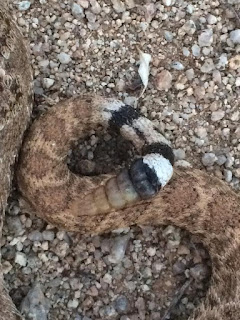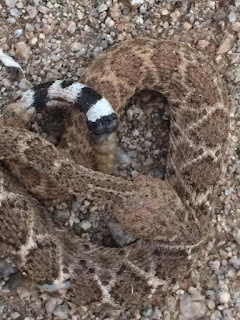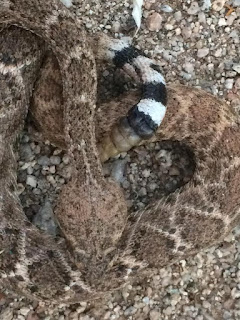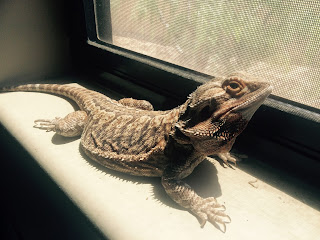
Crotalus atrox, the western diamondback rattlesnake, is a venomous rattlesnake species found in the United States and Mexico. It is likely responsible for the majority of snakebite fatalities in northern Mexico and the second-greatest number in the USA after C. adamanteus. No subspecies is currently recognized
Adults commonly grow to 120 cm (4 ft) in length. Specimens over 150 cm (5 ft) are infrequently encountered, while those over 180 cm (6 ft) are very rare. The maximum reported length considered to be reliable is 213 cm (7 ft). Males become much larger than females, although this difference in size does not occur until after they have reached sexual maturity. Rattlesnakes of this species considered medium-sized weighed 1.8 to 2.7 kg (4 to 6 lb), while very large specimens can reportedly weigh up to 6.7 kg (15 lb)

The color pattern generally consists of a dusty-looking gray-brown ground color, but it may also be pinkish-brown, brick red, yellowish, pinkish, or chalky white. This ground color is overlaid dorsally with a series of 24-25 dorsal body blotches that are dark gray-brown to brown in color. The first of these may be a pair of short stripes that extend backwards to eventually merge. Some of the first few blotches may be somewhat rectangular, but then become more hexagonal and eventually take on a distinctive diamond shape. The tail has two to eight (usually four to six) black bands separated by ash white or pale gray interspaces; this led to the nickname of "coon tail", though other species (e.g., Mojave rattlesnake) have similarly banded tails. Its postocular stripe is smoky gray or dark gray-brown and extends diagonally from the lower edge of the eye across the side of the head. This stripe is usually bordered below by a white stripe running from the upper preocular scale down to the supralabial scales just below and behind the eye. Its off-white belly is usually unmarked, its anal scale is undivided, and its dorsal scales are extremely keeled, often in rows of 25 to 27 near the midbody.

The wide range of this species overlaps, or is close to, that of many others. It may be confused with them, but differences exist. The Mohave rattlesnake, C. scutulatus, also has tail rings, but the black rings are narrow relative to the pale ones. The timber rattlesnake, C. horridus, has no tail rings. In the western rattlesnake, C. oreganus, the pale tail rings are the same color as the ground. The tail of the black-tailed rattlesnake, C. molossus, is a uniform black, or has indistinct tail rings. The Mexican west coast rattlesnake, C. basiliscus, also has a mostly dark tail with obscure or absent rings. The tiger rattlesnake, C. tigris, has a relatively small head and large rattle along with a dorsal pattern consisting more of crossbands. The Middle American rattlesnake, C. simus, has a generally uniform gray tail without any rings, as well as a pair of distinctive paravertebral stripes running down the neck. Members of the genus Sistrurus lack tail rings and have enlarged head plates.


Common names for this species include: western diamondback rattlesnake, western diamond-backed rattlesnake, adobe snake, Arizona diamond rattlesnake, coon tail, desert diamond-back, desert diamond rattlesnake, fierce rattlesnake, spitting rattlesnake, Texan rattlesnake, and Texas diamond-back, and Texas Rattler
Its habitats range from flat coastal plains to steep rocky canyons and hillsides; it is associated with many different vegetation types, including desert, sandy creosote areas, mesquite grassland, desert scrub, and pine-oak forests. Towards the southern













